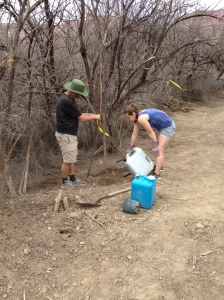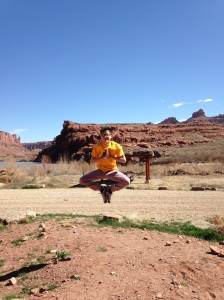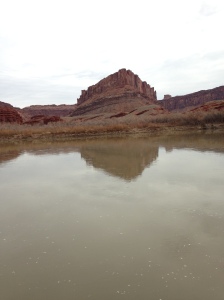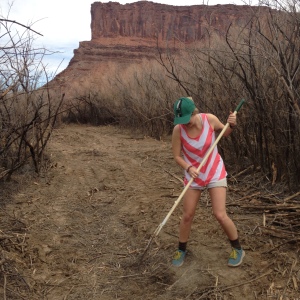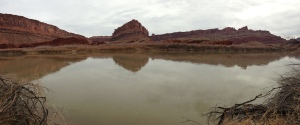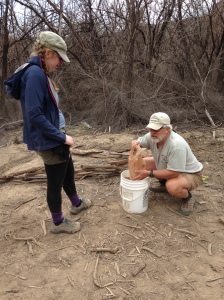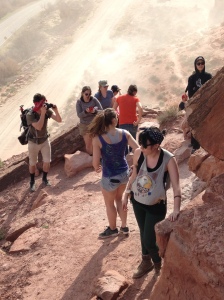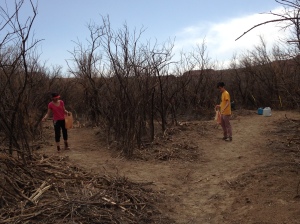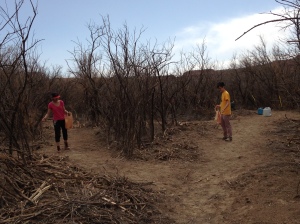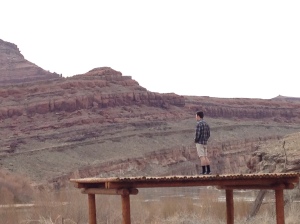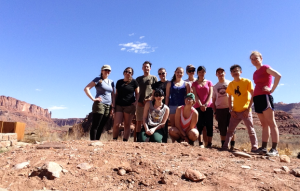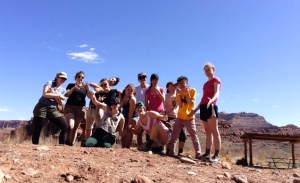ASB Monday
3/17/14
Happy Saint Patrick’s Day from the desert! Another ungodly early morning meant waking, again, before the sun. No complaints here however because the waning moon in Virgo greeted me from the whimsical sky this morning. On today’s agenda we had more invasive species removal planned with the Plateau Restoration Conservation. The Plateau Restoration Conservation is a nonprofit I found while researching Moab by literally searching “nonprofits in Moab”. It is a nonprofit based on the stewardship and improvement of natural areas including wildlife and flora habitats in Moab. We were working in a plateau area north of Moab behind the Potash Extraction Facility, a salt processing plant. (Don’t ask me what that entails because I have no idea, although I do know that the soil and rock formations in Moab are very salty. This was an interesting area that I had never been in before, but we were excited to see what we’d be doing for the day.
Bright and early we met Tamsin and Michael and walked over to the worksite where we were briefed about safety and the work we would be doing, which would be more invasive species removal of course! We would be clearing paths in an area that had already been worked on and initially cleared to encourage animals and native plants to move in. Instead of piling tamarisk debris into large stacks to be burned, we were going to be moving it off the paths so native species could use it as shade and in turn grow more successfully. We also got to build animal habitats, which was obviously my favorite part. Even though we were doing the same invasive species removal that we were doing with Clay, the object was different. This work was very labor intensive, but it was rewarding because we could easily see the difference we were making.
Most of the participants were having a lot of fun chopping, digging and throwing tamarisk branches off the path; however some did struggle. After a very manual labor-heavy day of work on Sunday, some participants were tired and clearly were not thrilled with doing the same kind of work on Monday. Unfortunately, I think this is where one of our participants checked out, stopped working hard and stopped being enthusiastic. Despite this disappointing reality, I appreciated the energy and work of each and every one of our participants, even and especially this one.
Michael, Tamsin and David, our other helper, were extremely grateful for our help. They were eager to share their knowledge over everything from tamarisk plants to Moab to college. The discussion was interesting too—I remember a vivid conversation with Michael and how frustrating the government shutdown was last year. The furlough of government employees affected the planning of our trip, but that was just about the extent of my relationship with it. Michael told me that it significantly affected many of his friends in extremely negative ways, and that most of the parks in the area, especially in Moab and Grand Canyon National Park (which we’d be traveling to later in the week) were still two months behind because of it. He said that he saw many of his friends in Flagstaff and other national parks have to close their businesses temporarily and some even permanently. Gazing upon the massive expansive of land that we were working in now, and knowing that natural areas that need invasive species removal is never-ending, I can’t even imagine how discouraging and downright angering the shutdown was for those professionals whose fields depend on government funding. Even now, national park and other preservative organizations experience budget cuts every single year yet their workload steadily increases. Michael told me that the federal government seems to be interested in national parks when it can make money from park entry fees, but has very little interest in actually improving the state of the land or the species that dwell on it.
After our enlightening conversation, I couldn’t help but appreciate how enthusiastic and focused the individuals I had built relationships with were about their gigantic task at hand. I never heard so much as a sliver of bitterness from them about the jackass who introduced tamarisk and Russian thistle to the United States and the insane amount of work that it is taking and will take to rid us of it, if that is even possible. (I, however, am not above bitterness toward the jackass who brought tumbledevil here.) It takes a certain kind of person to attempt to tackle a job so seemingly impossible to complete. I feel grateful that we got to spend whole days with people like this. I hope some of their serenity when facing daunting tasks rubbed off on me.
At the end of the day, we got to plant native species in the areas we’d cleared. This was a perfect way to end the day because after shoveling, hoeing, raking and everything in between with gloves on, it felt nice to shed them and take a gentle touch to the little seedlings we were carefully placing in the ground and watering. After our area was cleared, it was named Wyoming, and then we got to head over to an area that was cleared the year before. We got to see that the technique was working! There were native species thriving in the shade of the tamarisk brambles. It was at this moment that I realized how important what we were actually doing was. So often we are caught up in immediate gratification and if instant results aren’t visible, the job wasn’t productive. But in real life, the most important actions don’t end in an immediate result. Ever. The most important energy used, as I’ve realized working my ass off to rid the land of tamarisk and tumbleweed, is the kind that is gradual. It takes time to create something beautiful. It takes time recreate the beauty that probably was destroyed in a few minutes. It takes time to make a real difference, and one full day or week or even year might not be enough. But time starts with one minute, one hour, or one day. Building a healthy foundation is the most important thing, in life and in invasive species removal, and by pouring our love and hard work into something we set it up to be successful in the future.

